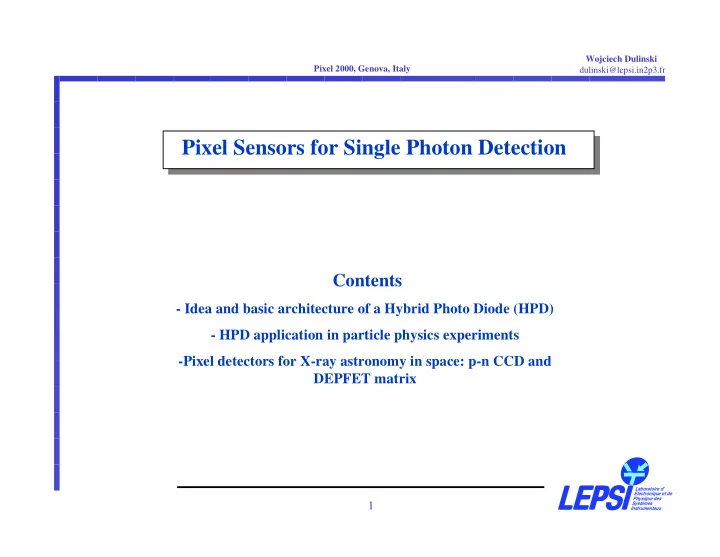

Wojciech Dulinski Pixel 2000, Genova, Italy dulinski@lepsi.in2p3.fr Pixel Sensors for Single Photon Detection Contents - Idea and basic architecture of a Hybrid Photo Diode (HPD) - HPD application in particle physics experiments -Pixel detectors for X-ray astronomy in space: p-n CCD and DEPFET matrix LEPSI LEPSI Laboratoire d’ Electronique et de Physique des 1 Systèmes Instrumentaux
Wojciech Dulinski Pixel 2000, Genova, Italy dulinski@lepsi.in2p3.fr Hybrid Photo Diode (Hybrid Photo Detector) LEPSI LEPSI Laboratoire d’ Electronique et de Physique des 2 Systèmes Instrumentaux
Wojciech Dulinski Pixel 2000, Genova, Italy dulinski@lepsi.in2p3.fr Single (visible) photon counting efficiency comes from limited QE of HPD photocathode LEPSI LEPSI Laboratoire d’ Electronique et de Physique des 3 Systèmes Instrumentaux
Wojciech Dulinski Pixel 2000, Genova, Italy dulinski@lepsi.in2p3.fr Highly-segmented silicon sensor with low noise VLSI readout electronics as an active element of HPD LEPSI LEPSI Laboratoire d’ Electronique et de Physique des 4 Systèmes Instrumentaux
Wojciech Dulinski Pixel 2000, Genova, Italy dulinski@lepsi.in2p3.fr Next logical step : silicon pixel array bump-bonded to a binary readout chip (LHC1) M.Alemi et al., CERN-EP/99-110 (1999) LEPSI LEPSI Laboratoire d’ Electronique et de Physique des 5 Systèmes Instrumentaux
Wojciech Dulinski Pixel 2000, Genova, Italy dulinski@lepsi.in2p3.fr Some remaining problems before having a practical device... M.Alemi et al., CERN-EP/99-110 (1999) LEPSI LEPSI Laboratoire d’ Electronique et de Physique des 6 Systèmes Instrumentaux
Wojciech Dulinski Pixel 2000, Genova, Italy dulinski@lepsi.in2p3.fr Potential application for back-illuminated, thinned CMOS APS devices for HPD integrated sensor - excellent noise figures - high spatial resolution LEPSI LEPSI Laboratoire d’ Electronique et de Physique des 7 Systèmes Instrumentaux
Wojciech Dulinski Pixel 2000, Genova, Italy dulinski@lepsi.in2p3.fr Pixel-HPD application : LHCb-RICH detector M.Albrecht et al., NIM A 442 (2000) 164 LEPSI LEPSI Laboratoire d’ Electronique et de Physique des 8 Systèmes Instrumentaux
Wojciech Dulinski Pixel 2000, Genova, Italy dulinski@lepsi.in2p3.fr Particle tracking using: HPD + scintillating fibres or phosphor scintillator + CMOS Imager IEEE TNS Vol.43, No.3 June 1996, 2115 TOTEM experiment at CERN LHC LEPSI LEPSI Laboratoire d’ Electronique et de Physique des 9 Systèmes Instrumentaux
Wojciech Dulinski Pixel 2000, Genova, Italy dulinski@lepsi.in2p3.fr Pixel-HPD application : ISPA (Imaging Silicon Pixel Array) Camera for Gamma Rays D. Puertolas et al., IEEE TNS Vol.42, No.6 December 1996, p.2221 LEPSI LEPSI Laboratoire d’ Electronique et de Physique des 10 Systèmes Instrumentaux
Wojciech Dulinski Pixel 2000, Genova, Italy dulinski@lepsi.in2p3.fr ISPA Camera for Gamma Rays energy resolution (122 keV) and spatial resolution D. Puertolas et al., IEEE TNS Vol.44, No.6 October 1997, p.1747 LEPSI LEPSI Laboratoire d’ Electronique et de Physique des 11 Systèmes Instrumentaux
Wojciech Dulinski Pixel 2000, Genova, Italy dulinski@lepsi.in2p3.fr Fully Depleted pn-CCD - derivative of the silicon drift detector (Gatti and Rehak, 1983) - JFET electronics integrated (1993) - large area detectors (1995-1997) for (soft) X-ray astronomy in space Fully depleted detector volume (silicon, 300 mm thick) + extremely low noise level (ENC ~5 el.) = high quantum efficiency (single photon counting mode) LEPSI LEPSI Laboratoire d’ Electronique et de Physique des 12 Systèmes Instrumentaux
Wojciech Dulinski Pixel 2000, Genova, Italy dulinski@lepsi.in2p3.fr pn-CCD : principal features P.Hall et al., SPIE, 3114: 126-133, 1977C LEPSI LEPSI Laboratoire d’ Electronique et de Physique des 13 Systèmes Instrumentaux
Wojciech Dulinski Pixel 2000, Genova, Italy dulinski@lepsi.in2p3.fr pn-CCD : QE + Fe spectrum LEPSI LEPSI Laboratoire d’ Electronique et de Physique des 14 Systèmes Instrumentaux
Wojciech Dulinski Pixel 2000, Genova, Italy dulinski@lepsi.in2p3.fr pn-CCD : for X-ray Astronomy: XMM-Newton Observatory LEPSI LEPSI Laboratoire d’ Electronique et de Physique des 15 Systèmes Instrumentaux
Wojciech Dulinski Pixel 2000, Genova, Italy dulinski@lepsi.in2p3.fr Use of a high-energy physics detector technology : Back-illuminated, fully-depleted CCD image sensors for use on optical and near-IR astronomy D.E.Groom et al, NIM A 442 (2000) 216 LEPSI LEPSI Laboratoire d’ Electronique et de Physique des 16 Systèmes Instrumentaux
Wojciech Dulinski Pixel 2000, Genova, Italy dulinski@lepsi.in2p3.fr DEPFET Pixel Sensor for X-rays - can be back illuminated, can have a fill factor of 1, can be made very large (all pros of CCD) - does not need a charge transfer, no out-of-time events, every pixel is xy-addressable (all pros of APS) - in addition, can have a non destructive multiple readout to reach very low noise figures Device concept: combination of FET transistor with sideward depletion (drift chamber) J.Kemmer, G.Lutz et al. NIM A 288 (1990) 92 LEPSI LEPSI Laboratoire d’ Electronique et de Physique des 17 Systèmes Instrumentaux
Wojciech Dulinski Pixel 2000, Genova, Italy dulinski@lepsi.in2p3.fr DEPFET as pixel detector LEPSI LEPSI Laboratoire d’ Electronique et de Physique des 18 Systèmes Instrumentaux
Wojciech Dulinski Pixel 2000, Genova, Italy dulinski@lepsi.in2p3.fr DEPFET : excellent noise figures (9 electrons rms.) at room temperature! LEPSI LEPSI Laboratoire d’ Electronique et de Physique des 19 Systèmes Instrumentaux
Wojciech Dulinski Pixel 2000, Genova, Italy dulinski@lepsi.in2p3.fr Instead of conclusion and prospects... Posted: 2 Jun 2000 Quantum dots detect single photons A single-photon detector based on quantum dots has been developed for the first time by researchers at Toshiba's European laboratories in the UK. Conventionally single photons are detected by multiplying a photo-generated electron using an avalanche process. The Toshiba researchers, in collaboration with Cambridge University, developed a device for detection of single photons based on a GaAs/AlGaAs modulation doped field effect transistor (MODFET) which does not rely on avalanche processes. SPIE Web LEPSI LEPSI Laboratoire d’ Electronique et de Physique des 20 Systèmes Instrumentaux
Wojciech Dulinski Pixel 2000, Genova, Italy dulinski@lepsi.in2p3.fr Acknowledgements I’m very grateful to Thierry Gys (CERN) and Gerhard Lutz (MPI), for their efficient help in the preparation of this talk! LEPSI LEPSI Laboratoire d’ Electronique et de Physique des 21 Systèmes Instrumentaux
Recommend
More recommend